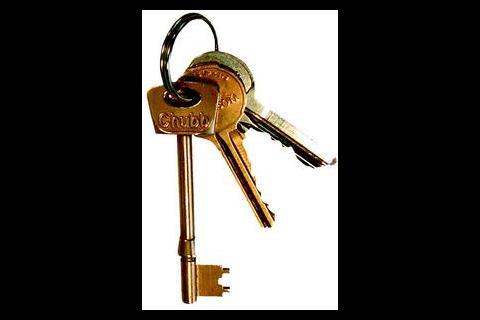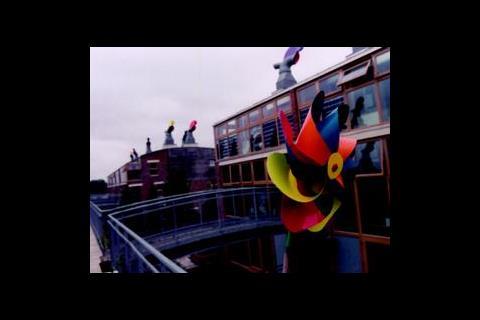Even if you didn’t know about ZED’s environmental characteristics, its homes look lighter and brighter. Almost all BedZED residents have gardens (small, but better than nothing) and verandas, compared to those living across the wall, who don’t. In BedZED homes, there is generally less brick on display, and more glass and wood. There is also a community hall, and specially provided space for children to play.
For BedZED architect Bill Dunster, these are the more important aspects of his project. If you think ZED is just about ‘green’ housing, then you’re very wrong. “We are aiming for a step change in culture; in lifestyle and work style,” says an impassioned Dunster. “The whole premise is that we can achieve a reduction in the environmental impact of houses, while increasing the quality of life for most ordinary people – that is, for the majority.”
Concern about how we live our lives is at the heart of Dunster’s mission. Over consumption of energy, high imports of food and too much waste are just some of the problems society is creating for itself. Figures show that UK families spend one third of their energy use on transport; one third on heating and power; and the rest on ‘food miles’ ie consumption of imported groceries. ZED is about tackling all these issues. Dunster’s wants to create a holistic approach to innovation in UK housebuilding. It isn’t just about grey water recycling, electric cars and chp. “If you are an ordinary person living in suburbia, that way of life has become so dysfunctional. The ideas in this project really do offer a better way of working and living.” Around 35% of the space at BedZED is given over to working areas
This is why Dunster stresses that ZED residents don’t necessarily have to be environmentally committed. He is aware that to encourage people to live this way requires more than an appeal to our inner environmentalist: “You may or may not be interested in environmental responsibility. This is simply a better way of doing things. You can’t force people to agree, but you can make it hard to ignore. You have to make it sexy, fun and desirable. Most of the current product of the housing sector is tired, naff and very very dangerous.”
The aim of Dunster’s practice, BD Architects ZEDFactory, is to create more zero energy developments around the UK. In this way, the ZED concept will move beyond the experimental, and become more affordable. “BedZED is a prototype, and that’s always more expensive. We need to produce greater volume to drive down costs,” says Dunster.
That is the idea behind his new publication, From A to ZED: realising zero fossil energy developments. In this book Dunster explains how a greater volume of his type of home could be produced: “If just 1000 homes from the anticipated programme of 180 000 plus homes a year were to adopt the technologies in BedZED, it would stimulate enough throughput for the supply chain to be able to slash the costs of replicating BedZED’s specification. The premium would then be as low as 15% above Build Regs minimum. All it needs is a dozen local authorities to help foster a ZED development in their domain and Britain would lead Europe in promoting a society powered by renewable energy.”
At the heart of this drive to greater volume is the Zed in a Box concept. Dunster and his team have created a number of standard ZED house types such as a ground floor one bedroom flat or a second floor three bedroom flat. All the innovations used at BedZED are included in these standard types. Dunster comments in A to ZED: “In the longer term, by adopting the ZED specification, volume housing can achieve the economies of scale needed to reduce ZED supply chain costs, and so make ZED specification competitive with current volume housing design.”
Alongside the design, is an open book development appraisal system. This is in the form of a spreadsheet pricing database, integrated with development appraisal software. Users can match a development’s density with the costs of building ZED-style homes, while retaining an industry-standard developer’s profit.
The process emphasises joined-up thinking. An integrated supply chain is necessary for the success of a ZED project. This is partly to do with the technology Dunster uses which has knock-on effects. For example, use of community heating chp plant requires a certain density of housing in order to maximise its efficiency. Dunster believes that the current organisation of construction hinders environmental development: “The idea is to package all this so that it is joined up thinking. The problem is that in construction we divide ourselves, so we are segregated, separate and specialist. Everyone occupies their silo, and they’re asked not to step outside it. Everything has to be jumbled up and thrown into the melting pot.”
Bill Dunster is a visionary, and believes strongly in the sustainable lifestyle as a way forward. However, he is currently frustrated by the lack of support for ZED housing – publication of A to ZED is largely about educating local authorities and central government about this way of designing homes. But he is determined to take the zero energy concept forward. Dunster would like to see a high-rise development in Wandsworth, West London get off the ground. SkyZED would be carbon negative: the building generates enough surplus renewable energy over its lifetime to meet their annual energy usage, as well as paying off the energy used in construction.
But it could be that this architect’s time is coming. Mayor Ken Livingstone’s London Plan calls for zero energy developments in every borough (see news analysis page 9).
Dunster’s vision contains several lessons for the construction industry. Firstly, buildings can’t be considered in isolation from their surroundings when we think of sustainability. We must understand buildings in the wider context of geography and society.
Secondly, sustainable features can’t be stuck on, like decorations. Technology such as chp, or using passive solar architecture must be designed in from the start.
Most clearly, Dunster and his ZED projects exemplify the strengths gained by joined-up thinking. Abandoning silo mentality and adopting an open approach to sharing information is the only way to create sustainable buildings, whether they’re domestic or commercial.
The ZED lifestyle – more than a house
Of the carbon dioxide generated by a person over their lifetime, their home causes only a third. This is why Bill Dunster stresses a holistic approach to dealing with global warming.The ultimate aim of ZED is to reduce the ecological footprint of individuals. At the moment, the typical UK lifestyle means that we each take up 6·19 hectares. This means we’re effectively living on three planets, not one.
A ‘typical’ way of life includes:
- owning a car;
- taking holidays by plane every year;
- eating out-of-season, highly packaged food ;n recycling 11% of domestic waste.
In order to occupy only one planet, we each need to take up only 1·9 hectares. The ‘ideal’ ZED lifestyle incorporates:
- living and working in a ZED;
- recycling office paper;
- no car (a member of the local car pool club);
- holiday by plane every two years;
- recycling 80% domestic waste;
- low meat diet with local fresh food.
The next generation of ZEDs will go a step further and be carbon negative. The combination of lifestyle and building design will neutralise the embodied energy of construction.
Source
Building Sustainable Design

























No comments yet